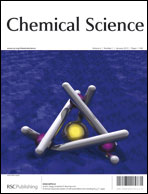Cooperative and competitive effects associated with Fe(CO)3 binding to annelated benzenes†
Abstract
Density functional theory (DFT) calculations have been carried out on the sequential transfer of Fe(CO)3 groups from the Fe(CO)3 complex of cyclobutadiene [CBD–Fe(CO)3, 5] to tris(etheno)-annelated benzene (3) and to 1,2;4,5-bis(etheno)-annelated benzene (9). The changes in the electronic structure of the central benzene ring in 3, brought about by each Fe(CO)3 transfer reaction, make the transfer of Fe(CO)3 groups to 3 from 1–3 molecules of 5 cooperative. Our calculations find that, as the number of Fe(CO)3 groups transferred to 3 increases, the bond lengths between the benzo carbons and each Fe atom decrease; and the energetic favorability of each Fe(CO)3 transfer reaction increases. In contrast, the transfer of Fe(CO)3 groups to 9 from two molecules of 5 is competitive. Transfer of a second Fe(CO)3 group from 5 to 9 increases the bond lengths between the benzo carbons and the Fe atoms and makes the second Fe(CO)3 transfer reaction more energetically unfavorable than the first. Our calculations also indicate that there is little, if any, π bonding between the three CBD–Fe(CO)3 rings in 8, the tris-Fe(CO)3 adduct of 3. Therefore, π bonding between the four-membered rings in 8 cannot explain the comparatively favorable energy for its formation.


 Please wait while we load your content...
Please wait while we load your content...